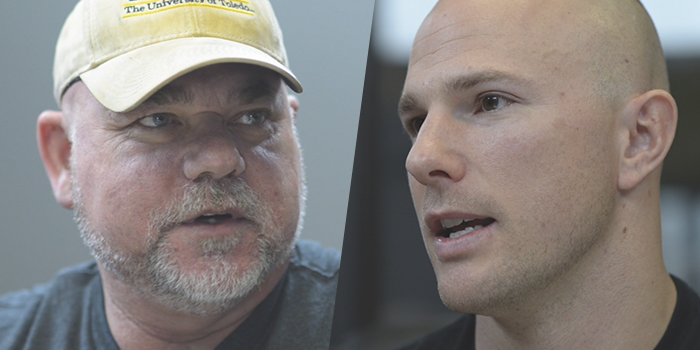
Editor's Note: Fixing Dave Tate is an educational video series intended for demonstration purposes only (acts as a case study specific to Dave Tate). It is not intended to medically diagnose, treat, or manage symptoms. If you are in pain, please consult a licensed healthcare professional.
Thus far in the Fixing Dave Tate series, Dr. John Rusin and Dave have gone through an initial intake assessment conversation, a comprehensive movement screening, and an orthopedic evaluation. At this stage, it is now time to review the orthopedic evaluation and interpret the results. In this video, Dr. Rusin and Dave discuss the findings from the first three stages and determine the focus moving forward. Dr. Rusin begins by saying there are three key things he wants to discuss after their hours of pre-testing. The goal is to find the lynchpin — the one thing currently that can be improved right now to see improvement. For Dave, he sees three.
The first is hip stability, specifically bilaterally. The right hip is going to get more attention than the left because it is more of a challenge. To accomplish this, Dr. Rusin explains that efforts will include focused attention on the torso and lat activation, as well as the glutes and adductors. One method of accomplishing this will be to re-stabilize single-leg movements and integrate them into training.
The second area of focus is two-fold: posterior chain upper quadrant stability and thoracic spine cage mobility. What this means is that they will attempt to reduce the movement restriction and pain in Dave's shoulder by working on his thoracic region. To target this, Dr. Rusin explains the importance of working on thoracic movement and "unlocking" the ribcage. Similar to the hip restriction, the lats will play a large role here, but in the case of the thoracic work Dr. Rusin explains that the key will be eccentric control of the lats. Dr. Rusin also lists a number of secondary consideration factors they will need to keep in mind throughout this process, including daily life modifications and being mindful of symptomatic positions for Dave's shoulder.
The third focus identified by Dr. Rusin is creating a program that is well-rounded for Dave. Unlike the first two goals, which target specific physical issues Dave is experiencing, this goal is about being globally-minded and revolutionizing his approach to training. Dr. Rusin explains that for this goal, the approach will be to think of training in the general terms of conditioning and preparing to train like an athlete, doing accessory work like a bodybuilder, and keeping Dave's marquee strength lifts in the program. This must be done with a holistic, well-rounded approach for general fitness, with a focus on getting pain-free.
To accomplish this, Dave will have to do some things that Dr. Rusin refers to as "novelty." This means things such rotational work, single-leg work, and carries — all of which have been absent from Dave's training for quite some time. Dr. Rusin's belief is that a well-rounded program has six foundational movement patterns: squat, hinge, lunge, push, pull, and carry. For Dave this also needs to include cardiovascular work for the aerobic system and anaerobic system. There will be specific accommodations made for Dave and his current state (such as his two fake hips), but these guidelines will be the starting point for training moving forward.
Dr. Rusin then explains the next steps, which will begin with teaching a number of movements to Dave and evaluating how they will play into the programming. The specifics of the training plan will then be developed in unison by Dave and Dr. Rusin. They will also evaluate how Dave has been performing the majority of his movements, test the six foundational movement patterns to gain an understanding about the things Dave can do well without pain symptoms, and use those movements accordingly. The goal is to develop something between 12 and 15 minutes long that will prepare Dave fully to train. This process will be about repeat exposure; as Dave does these things day in and day out, he'll get better at the motor skills and develop proficiencies through incremental improvement.
To finish the video, Dave points out that his relative silence throughout the course of these conversations is due to his focus on trying to learn as much as he can while working with Dr. Rusin. Though it may appear to be non-compliance, the silence is actually indicative of Dave's efforts to learn rather than display his own knowledge.
By the minute:
- (1:10) Correlations from all three evaluations and finding lynchpins
- (2:40) Focus #1: Hip stability
- (4:47) Focus #2: Posterior chain upper quadrant stability and thoracic spine cage mobility
- (9:05) Focus #3: Globally-minded program formation
- (13:30) Next steps for Dave
- (16:35) Dave's thoughts on learning through silence
FIXING DAVE TATE SERIES
- Initial Assessment with Dr. John Rusin
- Movement Screening
- Orthopedic Evaluation
- The Three Areas of Focus Discovered During Initial Evaluation
- Observing Dave's Current Training Capabilities
- Programming the Six-Phase Dynamic Warm-up Sequence
- The Dynamic Warm-Up Sequences for Upper Body and Lower Body









